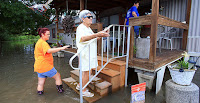Over the past year alone, catastrophic rain events characterized as once-in-500-year or even once-in-1,000-year events have flooded West Virginia, Texas, Oklahoma, South Carolina and now Louisiana, sweeping in billions of dollars of property damage and deaths along with the high waters.
These extreme weather events are forcing many communities to confront what could signal a new climate change normal. Now many are asking themselves: Are they doing enough to plan for and to adapt to large rain events that climate scientists predict will become more frequent and more intense as global temperatures continue to rise?
The answer in many communities is no, it's not enough.
They could be doing much, much more to adapt — not just people and how they respond to climate change, but homes, buildings, roads, and levees and other infrastructure, said Gavin Smith, director of the Department of Homeland Security's Coastal Resilience Center of Excellence and a research professor at the University of North Carolina's Department of City and Regional Planning.
One of the first shifts that must happen, many experts in hazard mitigation say, is to stop using the climate of the past to plan for the future.
"One of the great challenges is to recognize that a lot of communities, a lot of cities, a lot of human settlements in general were designed to reflect the climate of the past," said Smith, who also served as the director of the Mississippi Office of Recovery and Renewal after Hurricane Katrina.
"These issues, they are happening and they're going to become worse, and the changes are occurring within a context where we've designed cities to reflect a previous climate," he said.
The 39-hour rain event in Louisiana, which killed at least nine people and flooded upward of 40,000 homes, was a radical weather system that would have done plenty of damage, global warming or no. The same was true for a July 30 flash flood in Ellicott City, Md., which killed two people and swept a wave of destruction through the historic downtown when 6 inches of rain fell over several hours.
...
What climate scientists do know is that the intensity of extreme precipitation events is on the rise. With rising global temperatures, the 2014 National Climate Assessment predicts that many communities will see such extreme precipitation events more frequently.
More frequent events could defy traditional methods of planning for floods, like using 100- and 500-year floodplain maps to plan communities and develop flood insurance rates and who has to have it. It could also radically shift how engineers and architects design buildings. Coupled with sea-level rise in some places, such rain events could also affect how emergency response teams issue storm warnings or prepare people for weather events.
...
This will require a major shift in thinking, said Richard Wright, who heads the American Society of Civil Engineers' climate adaptation committee. The society releases a report card every four years identifying old, outdated and deteriorated infrastructure across the United States. Engineers now must also think about change climate models.
...
He calls for an adaptive risk management approach to make buildings and infrastructure strong enough for what science knows about climate change, and adaptable to what is unknown. Adaptive risk management, which he and other engineers once called "low-regret decisionmaking," gives local, state and federal governments more wiggle room to change things if they need to make additional adaptations to a changing climate.
Read more at A New Normal Confronts Rain-Weary U.S. Communities

No comments:
Post a Comment